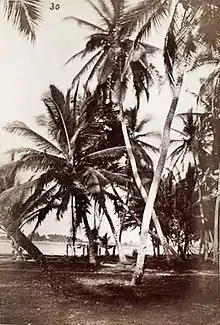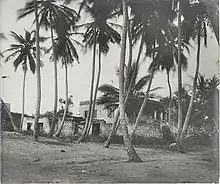Old Ningo
Old Ningo is a town in the Greater Accra Region of Ghana.
Old Ningo
Great Ningo | |
|---|---|
| Country | |
| Region | Greater Accra Region |
History

Also known as Great Ningo, the inhabitants have always been a fishing and farming community. They form part of the Ga-Adangbe people. The name Ningo has a much more widely known and accepted history as derived from the Ga–Dangme words nu meaning water and ngoo meaning salt.[1] The "nu" and "ngoo" story rather interesting is not as compelling as evidence which points to a more interesting origin. A publication in the Encyclopædia Metropolitana published in 1817 has this entry."Ningo, near which the second Danish castle, Friedensburg, is placed, is 43 miles from Akra. In Krob6, or Krepe, a large Negro State behind it, there is a very high mountain about 20 or 25 miles distant from the sea, and apparently capped with snow.".[2] It gives evidence to a voyager's inspired name as the name Ningo happens to be Latin for snow[3](Ningo in Latin), and as it goes the mariners would have seen the mountain [4] in the backdrop of the native settlers and named the place Ningo.Many other early writings[5] and references[6] on Ningo also used the term Grande in the form Ningo Grande, (grande) translate in Latin as large or great. The Name Great Ningo naturally follows.The people of Ningo like to refer themselves as "Nugoli" meaning "People of Nugo" ( Nugo being a much more locally accepted pronunciation of the name Ningo) and are proud to associate themselves with the name Great Ningo.The history of the people of Ningo is closely linked to the history of the Ga-Dangme people
Fort Fredensborg

The Danish were the first European settlers here, establishing the Fredensborg Fort in 1734. The town was developed as a slave trading station as part of Danish Guinea . However, with the abolition of the slave trade the town dwindled in size, with the fort staffed by a single person. The fort was already in ruins when the British took over on 8 March 1850 and incorporated the town into the Gold Coast.[7] Christian Glob Dorf was Commandant from 21 June 1740 to 25 May 1743.[8]
Education
The town is also known for the Ningo Secondary School regarded as having a pleasant environment.[9][10] The school is a second cycle institution.[11]
The founder of this prestigious school is Mr. Wilson Gbli Nartey. He was born at Lewem a suburb of the Great Ningo Traditional area. He was born to a fishing family. He lived and worked with his parents for most of his childhood days. Mr. Wilson was nicknamed WUDA as a short appellation for the name AMEWUDA which meant fear Your fellow human more than the snake. Mr. Wilson built the interest to study and become a Klake (Clerk) but was not allowed as he was supposed to work with the father in his business. But one day his life changed and he took an opportunity which came calling and his life changed. Pupils were organized to have a march Procession from Old Ningo through Lewem to wokumagbe and back to old ningo, the purpose was to create awareness of the IMPORTANCE OF BEING EDUCATED, he grew fond with this and run to his mum and begged her to allow him go with pupils. The mother hesitated for while with the fear that if His dad gets to know of this they won't be spared . But with so much enthusiasm he persuaded his mom and the mother packed a few clothes and sent him away with the students.
References
- "Old Nongo". Ghana Place Names. Ghana Place Names. Retrieved 8 November 2015.
- Encyclopædia Metropolitana; Or, Universal Dictionary of ..., Volume 20 edited by Edward Smedley, Hugh James Rose, Henry John Rose pg 24
- "Latin Definitions for: Ningo (Latin Search) - Latin Dictionary and Grammar Resources - Latdict".
- http://travelingluck.com/Africa/Ghana/Ghana+(general)/_2297364_Ningo.html Retrieved 15/4/2016
- A Practical Medico-Historical Account of the Western Coast of Africa, etc By James BOYLE (Surgeon.) Pg 332
- The Nautical Magazine a Journal of Papers on Subjects Connected with Maritime Affairs in General Fisher, Son & Company pg 646
- "Fort Fredensborg, Old Ningo". Ghana Museums and Monuments Board. Ghana Museums and Monuments Board. Retrieved 8 November 2015.
- Justesen, Ole (2005). Danish Sources for the History of Ghana, 1657-1754: 1657-1735. Copenhagen: Kgl. Danske Videnskabernes Selskab. p. 580. ISBN 9788773043127. Retrieved 8 November 2015.
- "Educational Institutions". www.centralregion.gov.gh. Archived from the original on 1 August 2017. Retrieved 12 August 2011.
- "References » Schools/Colleges". www.modernghana.com. Retrieved 12 August 2011.
- "List of Secondary Schools in Ghana". www.ghanaschoolsnet.com/. Retrieved 12 August 2011.